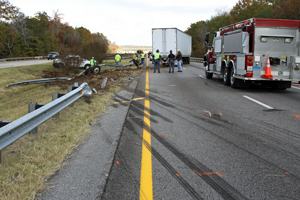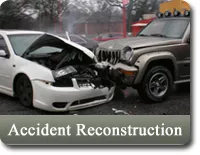For service in the Atlanta, Georgia area contact or call us:
Traffic Accident Reconstruction
Engineers and traffic accident reconstructionists analyze accident reconstruction. We analyze collisions for speed, position of vehicles on the roadway and identifying the driver. We use the latest technology such as HVE simulation, animations and the Crash Data Retrieval system by Bosch.
The following 10 steps briefly summarize the procedure for investigating and reconstructing an automobile accident, even though not all steps are performed in each accident case:
Traffic Accident Site Information
Initially, a forensic engineer or accident reconstructionist will gather all the facts together, such as police reports, photographs of vehicles and the accident scene taken by third parties, witness statements, 911 recordings, autopsy reports and other pertinent information.

Scene Investigation
Accident scenes provide roadway evidence need for reconstruction of the accident. Many times skid marks, yaw marks, fluid stains, vehicle debris, and gouge marks on pavement are left on the roadway and painted / flagged by police officers.
Measurements are taken at the scene so that an accident scene diagram can be prepared, showing site-specific conditions. This information is imperative in determining the point of impact and point of final rest of the vehicles, which can be used to draw conclusions on how the accident happened and calculate the speed of the vehicles.
Another significant part of the accident scene investigation is determining if the roadway contributed to the cause of the accident. We inspected the roadway for safety concerns such as a lack of traffic control devices and signage, lack of roadway maintenance, limited sight distance, lack of roadway maintenance, poor lighting, poor roadway design, poor stormwater drainage and other roadway defects.
Scene Mapping
The accident scene is measured / surveyed to provide a scaled drawing of the roadway evidence. This process is called scene mapping.
Skid marks, yaw marks, fluid stains, vehicle debris, and gouge marks on pavement are often left on the roadway because of the accident.
We put together and use these pieces of information to reconstruct the car accident. Other information, such as signage, traffic signals, and traffic control devices are shown on the drawing.

Vehicle Inspection & Analysis
Vehicles are inspected and analyzed to determine how vehicles collided, determine vehicle speeds, and check for defects that might have contributed to the accident.
Crush damage and paint transfer can determine how the vehicles came into contact with one another. Crush damage can determine the amount of force applied to the vehicle and determine a change in velocity (delta-V).
Vehicle Black Box Download Data
Most vehicles today have a black box (Event Data Recorder) which records information such as speed, throttle position, braking, seat belt usage prior to and during a crash event.
Whereas, commercial vehicles (i.e. tractor trailers) have an electronic control module (ECM) data which features much of the same data as a black box as well as diagnostic information for repairs and mechanical problems.

Review Witness Statements and Expert Testimony
Witness statements and expert testimony can assist the re-constructionist in determining how or why the accident happened. These documents are reviewed and considered when forming conclusions. Accident reconstruction is looking at all the data available.
Calculations for Accident Reconstruction
In reconstructing the accident, many physic and mathematical calculations are performed so that the engineer's opinions are scientifically supported.
The most typical calculations we perform deal with calculating the speed of the vehicles.
There are hundreds of calculations that our engineers are familiar with such as force, speed from skid marks, speed from crush damage, delta-V, momentum, rollover analysis, work, energy, motion, time-distance relationships, critical speed yaws, airborne analysis, vaults, throw distance, braking efficiency, closing speed, speed from RPM, etc.
3-D Accident Simulations
3-D Accident Simulations are created using computer software programs that implement physics and mathematical calculations to simulate the car accident. We use a site specific roadway environment along with the correct make and model vehicles.

Preparing a simulation is an iterative process where multiple simulation trials are run in order to match the position of each vehicle with the corresponding evidence on the roadway, such as the point of impact and point of rest.
The end result is a video that can show any angle of perspective, such as from the driver's viewpoint to an eyewitness view point. Simulation videos have proven to be very useful in court because it provides an accurate account of how the accident happened to the judge and jury.
On this live CNN news video, Elvin Aycock shows how this 3D simulation works as a tragic accident is reconstructed here...
Traffic Accident Report
A written report of an accident reconstruction provides a detailed explanation of the incident, procedures used, data collection, analysis and conclusions. The focus of the reconstruction engineer is to determine "how an accident happened."
Expert Witness
We are professional engineers and accident reconstruction engineers. We provide expert witness services to attorneys to explain the technical issues for the benefit of the court. We are very familiar with affidavits, Rule 26, depositions, court testimony, and preparing exhibits for presentation in court.
Frequently asked Questions about Collisions
Our experts determine:
- Vehicle speed,
- Amount of force applied between vehicle,
- If headlights, turn signals, tail lights or brake lights were incandescence at impact.
- Angles of impact,
- Determine if seat belts were in use at the time of the accident,
- Determine if there is any mechanical failure such as brake systems, tires/wheels, air bags, seat belts, and other safety equipment.
- Accident scene mapping data
- How an accident happened using simulation and animation.
Roadway evidence disappears soon after the accident, making it critically important to gather information as soon as possible.
Related Information about Traffic Accident Reconstruction
|
Collision analysis in 10 steps The accident scene investigation Atlanta Engineering Services, Inc. offers scene mapping... read more here Learn how a vehicle black box and it's downloads can prove up evidence View a sample engineering report here Why you need an expert witness Calculating the stopping distance Multiple surfaces calculator to determine the stopping distance when there is more to consider. Vehicle speed calculator |
Accidents involving motorcycles How a vehicle inspection analysis can help you after an accident Reconstructing accidents involving Non-Commercial trucks Read how vehicle defects can be the cause of a traffic accident here. It just may be those roadway ruts that caused you to hydroplane, find out more here Was it poor design or layout that caused the accident? See real 3D accident simulations with this link More 3D accident reconstruction videos can be found here See actual photos of traffic accidents here |
G-ZNJ8QW23K9
